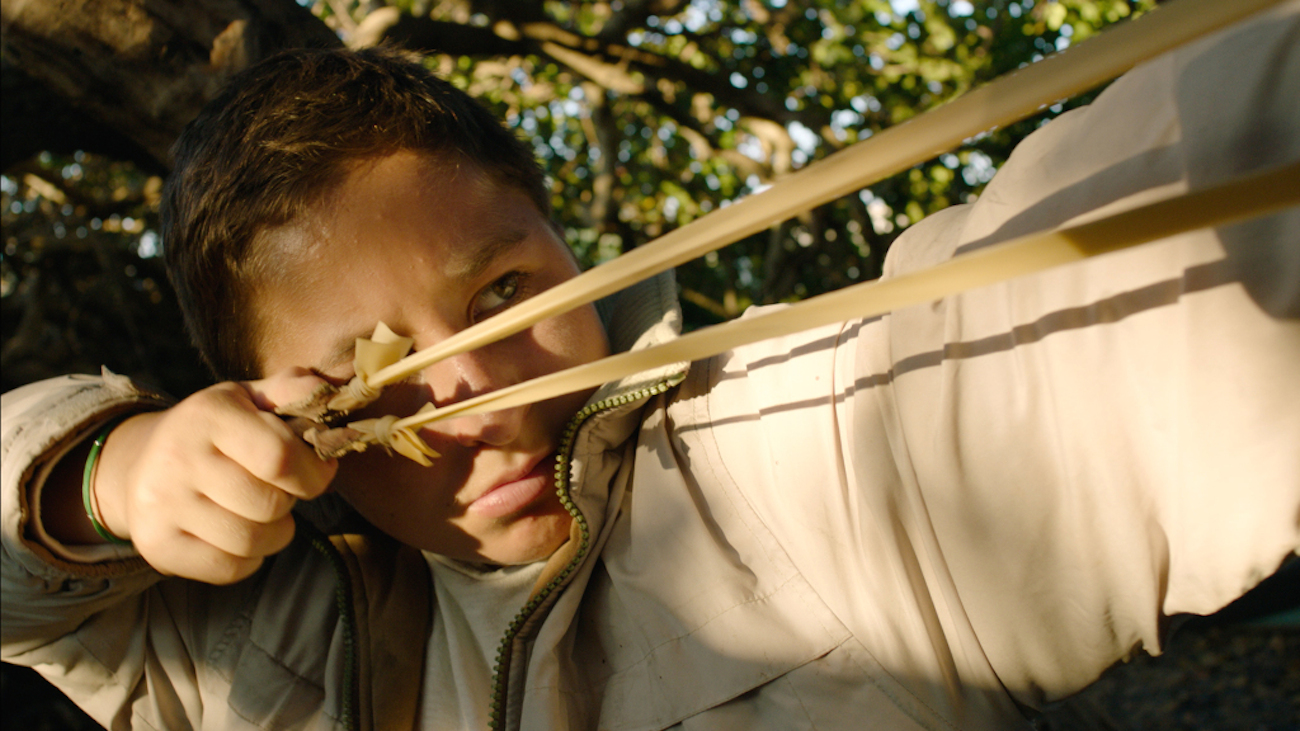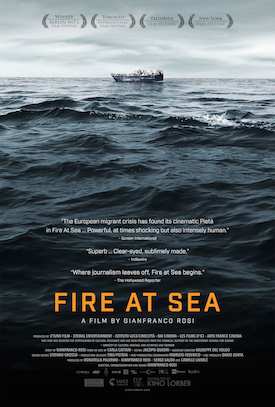 Samuele is 12 and lives on an Italian island in the Mediterranean, far away from the mainland. Like many boys of his age, he does not always enjoy going to school, he would much rather climb the rocks by the shore and play with his slingshot. But his home is not like other islands. For years, it has been the destination of men, women, and children trying to make the crossing from Africa in boats that are far too small and decrepit. The island is called Lampedusa and it has become Ground Zero in the flight of hundreds of thousands of refugees to Europe — people who are desperately looking for peace, freedom, and happiness, and yet whose dead bodies are often pulled out of the water. Thus, every day the inhabitants of Lampedusa are bearing witness to one the greatest humanitarian tragedies of our times. Gianfranco Rosi’s haunting documentary, winner of Golden Bear at the 2016 Berlin International Film Festival and Italy’s official submission for next year’s Best Foreign Language Film Academy Award (one of the first documentaries ever chosen for this honor), explores the emotional world of some of Lampedusa’s inhabitants who are every day exposed to this permanent state of emergency even those these two worlds barely touch. Meryl Streep, chair of this year’s Berlin jury, called Fire at Sea “a daring hybrid of captured footage and deliberate storytelling that allows us to consider what documentary can do. It is urgent, imaginative, and necessary filmmaking.” I sat down with the introspective director in Los Angeles.
Samuele is 12 and lives on an Italian island in the Mediterranean, far away from the mainland. Like many boys of his age, he does not always enjoy going to school, he would much rather climb the rocks by the shore and play with his slingshot. But his home is not like other islands. For years, it has been the destination of men, women, and children trying to make the crossing from Africa in boats that are far too small and decrepit. The island is called Lampedusa and it has become Ground Zero in the flight of hundreds of thousands of refugees to Europe — people who are desperately looking for peace, freedom, and happiness, and yet whose dead bodies are often pulled out of the water. Thus, every day the inhabitants of Lampedusa are bearing witness to one the greatest humanitarian tragedies of our times. Gianfranco Rosi’s haunting documentary, winner of Golden Bear at the 2016 Berlin International Film Festival and Italy’s official submission for next year’s Best Foreign Language Film Academy Award (one of the first documentaries ever chosen for this honor), explores the emotional world of some of Lampedusa’s inhabitants who are every day exposed to this permanent state of emergency even those these two worlds barely touch. Meryl Streep, chair of this year’s Berlin jury, called Fire at Sea “a daring hybrid of captured footage and deliberate storytelling that allows us to consider what documentary can do. It is urgent, imaginative, and necessary filmmaking.” I sat down with the introspective director in Los Angeles.
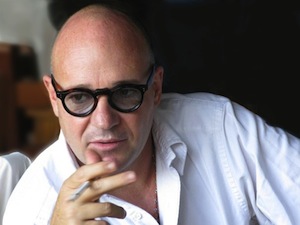 Danny Miller: I have to admit that started watching this film without any knowledge of what it was at all—
Danny Miller: I have to admit that started watching this film without any knowledge of what it was at all—
Gianfranco Rosi: Which is good, that’s the way it’s supposed to be!
As I watching, I kept thinking, wow, that young boy is such an amazing actor! I was stunned when I finally realized that this very poetic, moving film was a documentary and that all of the residents of Lampedusa were actual people just living their lives. All of your documentaries have a lyrical feeling to them and are such immersive experiences. I assume you have little interest in making a documentary in a more traditional style?
I don’t think so, no, because for me it’s very important to always use the language of cinema. I think we live in a world of so much information around us that in my work I try to go for something more emotional, more universal. I’m not interested in doing a “complaining/explaining” documentary — someone complaining and then people explaining why they’re complaining. I don’t like to answer questions in my work, I prefer raising more questions about a topic.
There are so many small, everyday moments in this film that become so meaningful when they are taken together and juxtaposed against the reality of what is also going on in Lampedusa with the migrants.
I like this sense of transformation of reality when things aren’t merely what they are at that moment but leave space for interpretation. I like when there are layers that you can peel away and go very deeply inside — into the inner world of every character. This little boy, Samuele, for example, seems to dance around so many metaphors in his daily life: his lazy eye, his nausea, his coming of age, the struggle of this little kid to face the difficulties of life and things he doesn’t know including this world pain and tragedy. That’s what I was interested in focusing on in Lampedusa — how these two worlds co-exist. How does the inner life of this boy also reflect the tragedy of what’s going on in Lampedusa?
When you make a movie in this way, do you have any idea at the beginning what it’s going to be like? Is there a moment when you say, “Ah, I’ve got a film now!”
I always know where I’m going to start a project but I never know where it will end. For me, it’s like a labyrinth, I have to find a way out. First, I had to know the place, Lampedusa, and then I had to see what was happening there — all these migrants arriving every day. Unlike a few years ago, there’s now there’s a border in the sea where the people are stopped and then brought onto the island. This created two separate worlds with very little interaction between the island and the people arriving there. Then I start finding these people who become characters in the film and we go on this journey with them — each of them helps to reflect the identity of the place. But I never know where this is going to take me, I just pray to the goddess of documentary!
For this film, did you start with Dr. Bartolo, the doctor on the island who is treating many of the migrants?
Yes, he was the first person who really engaged me. With this border in the sea, Lampedusa has become a kind of microcosm or metaphor for all of Europe even though it’s this tiny little place. There are these two realities that rarely encounter each other — the migrants passing through and the residents of the island — but Dr. Bartolo is the link to both.
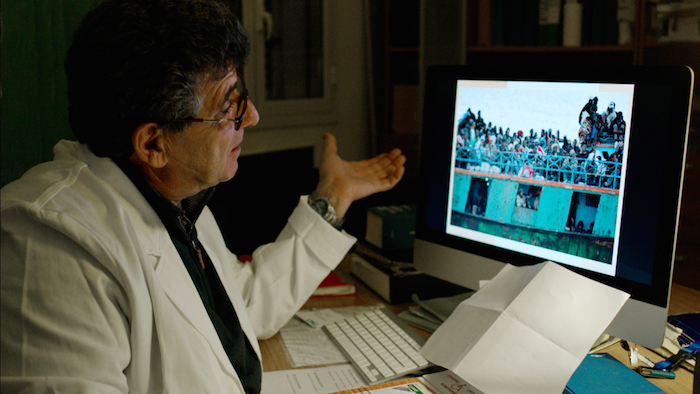
Did you consider focusing in on some of the migrants like you do with Samuele and the other Lampedusa residents?
That would have been very difficult to do. These people arrive there at night, get placed in this center where they are given some clothes and medical treatment, and then a day or two later they are sent to mainland Italy where they start the process of getting accepted as political refugees. It’s a very complicated thing. So the film is really about these three realities: the migrants arriving at Lampedusa, the people of the island with their own identities and stories, and Dr. Bartolo constantly moving in between these worlds — he’s the link along with the ships that patrol up and down and get involved with rescues in the middle of the sea that unfortunately often involve death.
While we know those scenes of horror are going on every day, it’s so powerful and sad to see what that actually looks like.
I only included one scene that really showed that towards the end of the film. You know, once you put your camera in a situation like that, all the strength that you need to keep working on a film just vanishes. I remember at that point I called my editor and said it was time to start editing, I couldn’t film anymore. I wanted the film to be a kind of memorial to the deaths of so many people, so the film was constructed in order to arrive at that moment, all the characters were involved in a journey to arrive there emotionally. And yet that could not be the final point of the film either — I had to go beyond that as a kind of mourning. So the last 10 minutes of the film are completely silent.
How do you work at balancing the poetic nature of the film with the harsh realities you are showing?
There is a resolution with each of the characters, something that changes. Every scene in the film is linked to a very strong reality, but my editing is more emotional and more narrative. I like that different people can read the film differently depending on what they bring to it. This is not a film that takes you from a neat beginning to an end. I think documentaries used to do this a lot more. If you think about the films of Robert Flaherty, there is an element of suspense in them that is extremely powerful.
Also the films of Frederick Wiseman.
Yes, exactly. But today there are many documentaries that are developed with a script — everything has to follow a certain progression and make sense and they have three weeks to shoot. That’s fine for some films but for me, when I start a movie, I never know where it’s going to end, it’s always a journey. I like to write with the camera.
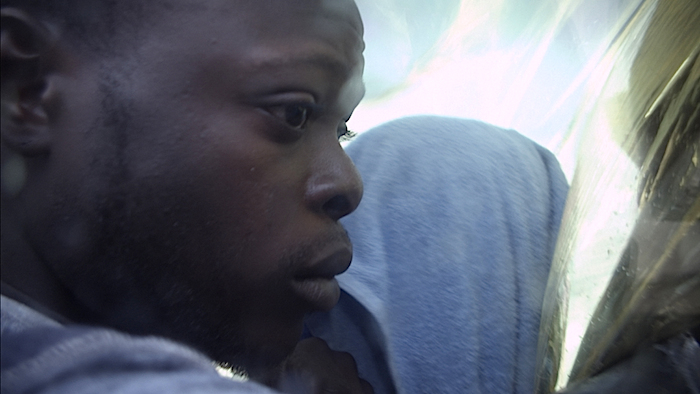
The scenes with migrants are so powerful. I can’t stop thinking of that moment where the group of Nigerians are spontaneously giving their “testimony.”
That was a real moment when I was able to have an exchange with them. I just happened to be on the Coast Guard boat when that rescue happened. In a way it was like shooting during a war situation, you’re trying to record things for history. The first time I saw the migrants getting their pictures taken with their numbers, I just started crying. When you see them with these numbers, it’s like they don’t have an identity anymore. I wanted to capture this embarrassment. They don’t know where to look, they don’t know what lies ahead but you can see their hope for a future life. This was their first step of identification, a very crude moment, and in some ways putting the camera there was violating my own ethics of filming but I had to do it. I wanted to be able to capture in their eyes that these are real individuals, not just numbers. There’s a boy at certain point who doesn’t know where to look — at the camera that’s taking his ID photo or at me. For me, those three seconds say so much.
What I love about that scene is that you see the very different personalities of each person come through. It’s so easy to think about these people just in terms of their huge numbers without stopping to remember that they are real flesh and blood human beings.
That’s the kind of space that I wanted to create, even in the scenes where they’re being examined and the police realize that so many of them are covered in gasoline from the boats.
Are those arrivals still happening every day in Lampedusa?
More and more all the time. And we cannot just continue to allow people to die in the middle of the sea in this way, it’s a human slaughter — one of the worse crises to happen in Europe since World War II. The dead people that I filmed, those people were suffocated by fumes inside the boat. There are often hundreds of people in the bottom of these horrible boats with very little air to breathe. And that one we just came across by chance. They didn’t even have a call radio, I just happened to be outside smoking a cigarette when I saw this little boat. I alerted the police and they sent a helicopter and then the rescue started. If we had been a few hours later many more people would have died and this kind of thing is happening every single day. They are put into these boats and told at the beginning of their journey that someone will retrieve them on the other hand but it’s not true. These people are all victims of human traffickers who just want their money. We need to find a way to intervene before they get into the boats.
Is there a growing movement in Italy to reject immigrants like there is here?
Oh yes, that’s happening all over Europe, unfortunately, and for me this is like the end of the European community. As soon as every country starts to make their own policy with referendums like Hungary did, “Do you want these migrants arriving in our country and changing our pure identity?” it’s all over. That’s what Brexit was all about, this fear of immigration.
That kind of fear has always been around, of course, but it seems to be getting worse and worse.
150 million people are moving all over the world, there’s no wall that can resist history. I thought President Obama’s speech at the United Nations was very powerful when he said that when you build a wall, you’re really building a prison for yourself. I think this is a very strong image. I, myself, came to Italy from Eritrea. I lived in a Europe that was open, I felt European, I felt I could move around Europe, my identity is European. I don’t want to have a Europe that is closing down. So many countries are refusing to accept people who have nowhere to go. It’s especially sad since our own politics have helped to create this mess that these people are now suffering from in Iraq, in Libya, in Syria, and all these places.
I hope that films like yours start to change the conversation. Compassion and humanitarian ideals seem to be on the low ebb right now which is very depressing.
I think we’re currently living in one of the worst periods of history. Politicians are constantly spreading fear of the other. My film is not one that bangs you on the head with a particular message, we give you a lot of freedom in how you see this tragedy. But then after the film is finished, people have a lot of questions which is what I want. The film opens with a message from the Coast Guard to one of these boats that is sinking. He says over and over again, “What’s your position? What’s your position?” For me, this is what I want people to go out from the movie and ask themselves. “What’s my position? What can I do?” I don’t think cinema can change the world or create a new reality, but we can definitely help bring awareness on certain things.
What’s happening ceases being a political issue and just more of a human issue.
The history of human rights starts with the right of each individual. One is an enormous number, one death is too much, and now we are talking about thousands of deaths every day, numbers that don’t even make any sense.

